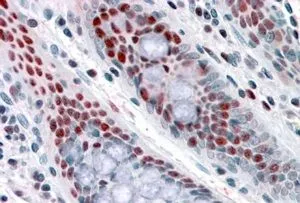NAT10 antibody [N1N2], N-term
GTX119166
ApplicationsImmunoFluorescence, Western Blot, ImmunoCytoChemistry, ImmunoHistoChemistry, ImmunoHistoChemistry Paraffin
Product group Antibodies
TargetNAT10
Overview
- SupplierGeneTex
- Product NameNAT10 antibody [N1N2], N-term
- Delivery Days Customer9
- Application Supplier NoteWB: 1:500-1:3000. ICC/IF: 1:100-1:1000. IHC-P: 1:100-1:1000. *Optimal dilutions/concentrations should be determined by the researcher.Not tested in other applications.
- ApplicationsImmunoFluorescence, Western Blot, ImmunoCytoChemistry, ImmunoHistoChemistry, ImmunoHistoChemistry Paraffin
- CertificationResearch Use Only
- ClonalityPolyclonal
- Concentration1 mg/ml
- ConjugateUnconjugated
- Gene ID55226
- Target nameNAT10
- Target descriptionN-acetyltransferase 10
- Target synonymsALP, Kre33, NET43, RNA cytidine acetyltransferase, 18S rRNA cytosine acetyltransferase, N-acetyltransferase 10 (GCN5-related), N-acetyltransferase-like protein
- HostRabbit
- IsotypeIgG
- Protein IDQ9H0A0
- Protein NameRNA cytidine acetyltransferase
- Scientific DescriptionHas protein acetyltransferase activity in vitro. Can acetylate both histones and microtubules. Histone acetylation may regulate transcription and mitotic chromosome de-condensation. Activates telomerase activity by stimulating the transcription of TERT, and may also regulate telomerase function by affecting the balance of telomerase subunit assembly, disassembly, and localization. Acetylates alpha-tubulin, which may affect microtubule stability and cell division.
- Storage Instruction-20°C or -80°C,2°C to 8°C
- UNSPSC12352203
References
- Alsarraj J, Faraji F, Geiger TR, et al. BRD4 short isoform interacts with RRP1B, SIPA1 and components of the LINC complex at the inner face of the nuclear membrane. PLoS One. 2013,8(11):e80746. doi: 10.1371/journal.pone.0080746Read this paper





